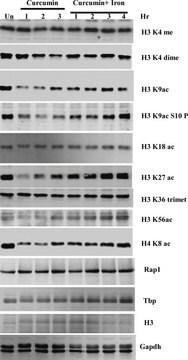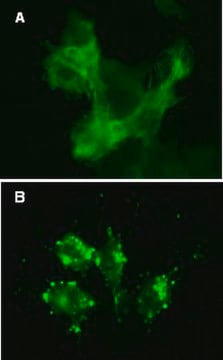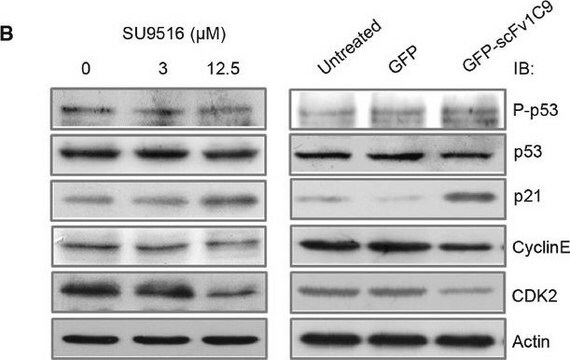PC712
Anti-p53 Binding Protein 1 (Ab-1) Rabbit pAb
liquid, Calbiochem®
Synonym(s):
Anti-53BP1
Sign Into View Organizational & Contract Pricing
Select a Size
All Photos(1)
Select a Size
Change View
About This Item
UNSPSC Code:
12352203
NACRES:
NA.43
Recommended Products
biological source
rabbit
Quality Level
antibody form
purified antibody
antibody product type
primary antibodies
clone
polyclonal
form
liquid
does not contain
preservative
species reactivity
mouse, human
manufacturer/tradename
Calbiochem®
storage condition
OK to freeze
avoid repeated freeze/thaw cycles
General description
Purified rabbit polyclonal antibody. Recognizes the ~230 kDa 53BP1 protein.
Recognizes the ~230 kDa 53BP1 protein in HeLa cell nuclear extract (Cat. No. WB64).
This Anti-p53 Binding Protein 1 (Ab-1) Rabbit pAb is validated for use in Immunoblotting, Immunofluorescence, Immunoprecipitation for the detection of p53 Binding Protein 1 (Ab-1).
Immunogen
Human
a recombinant protein consisting of human 53BP1 fused to a His•Tag sequence
Application
Immunoblotting (1:3000-1:5000)
Immunofluorescence (1:300-1:500, indirect)
Immunoprecipitation (1:300-1:500)
Immunofluorescence (1:300-1:500, indirect)
Immunoprecipitation (1:300-1:500)
Packaging
Please refer to vial label for lot-specific concentration.
Warning
Toxicity: Standard Handling (A)
Physical form
In 100 mM NaCl, 50 mM Tris-HCl, 20% glycerol, pH 7.6.
Reconstitution
Following initial thaw, aliquot and freeze (-70°C).
Analysis Note
Positive Control
HeLa Cell Nuclear Extract (Cat. No. WB64)
HeLa Cell Nuclear Extract (Cat. No. WB64)
Other Notes
Antibody should be titrated for optimal results in individual systems.
Legal Information
CALBIOCHEM is a registered trademark of Merck KGaA, Darmstadt, Germany
Not finding the right product?
Try our Product Selector Tool.
Storage Class
10 - Combustible liquids
wgk_germany
WGK 1
flash_point_f
Not applicable
flash_point_c
Not applicable
Certificates of Analysis (COA)
Search for Certificates of Analysis (COA) by entering the products Lot/Batch Number. Lot and Batch Numbers can be found on a product’s label following the words ‘Lot’ or ‘Batch’.
Already Own This Product?
Find documentation for the products that you have recently purchased in the Document Library.
Mariana Acevedo et al.
Cancer research, 76(11), 3252-3264 (2016-05-22)
Promyelocytic leukemia (PML) plays a tumor suppressive role by inducing cellular senescence in response to oncogenic stress. However, tumor cell lines fail to engage in complete senescence upon PML activation. In this study, we investigated the mechanisms underlying resistance to
Hiroshi Ikeuchi et al.
Oncogene (2024-08-03)
Identifying the mechanisms of action of anticancer drugs is an important step in the development of new drugs. In this study, we established a comprehensive screening platform consisting of 68 oncogenes (MANO panel), encompassing 243 genetic variants, to identify predictive
Mafuka Suzuki et al.
PloS one, 18(1), e0281168-e0281168 (2023-01-28)
Malignancy is often associated with therapeutic resistance and metastasis, usually arising after therapeutic treatment. These include radio- and chemo-therapies, which cause cancer cell death by inducing DNA double strand breaks (DSBs). However, it is still unclear how resistance to these
Yusuke Matsuno et al.
Nature communications, 10(1), 3925-3925 (2019-09-04)
Mismatch repair (MMR)-deficient cancers are characterized by microsatellite instability (MSI) and hypermutation. However, it remains unclear how MSI and hypermutation arise and contribute to cancer development. Here, we show that MSI and hypermutation are triggered by replication stress in an
Salma Akter et al.
Genes to cells : devoted to molecular & cellular mechanisms, 28(1), 53-67 (2022-11-24)
Steroid hormones induce the transcription of target genes by activating nuclear receptors. Early transcriptional response to various stimuli, including hormones, involves the active catalysis of topoisomerase II (TOP2) at transcription regulatory sequences. TOP2 untangles DNAs by transiently generating double-strand breaks
Our team of scientists has experience in all areas of research including Life Science, Material Science, Chemical Synthesis, Chromatography, Analytical and many others.
Contact Technical Service








